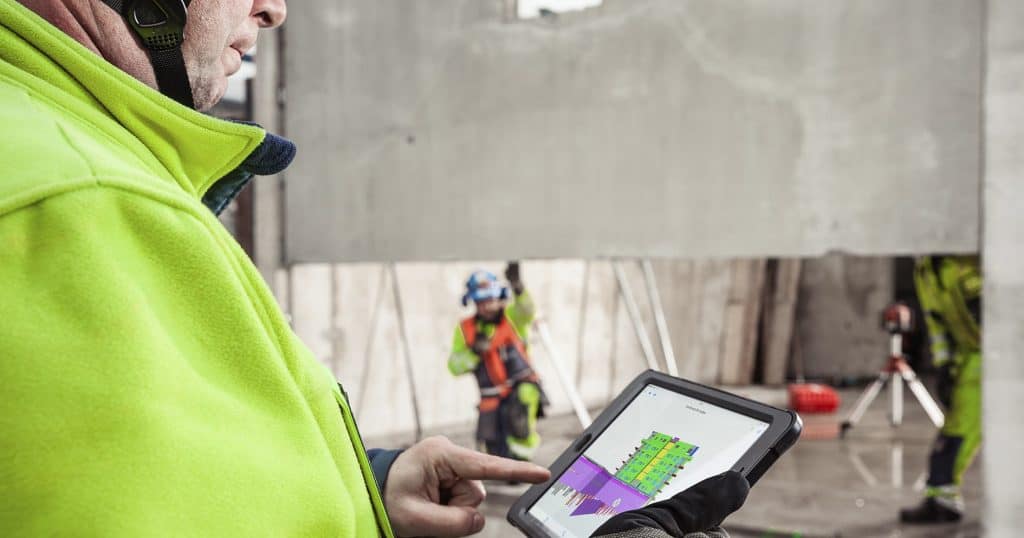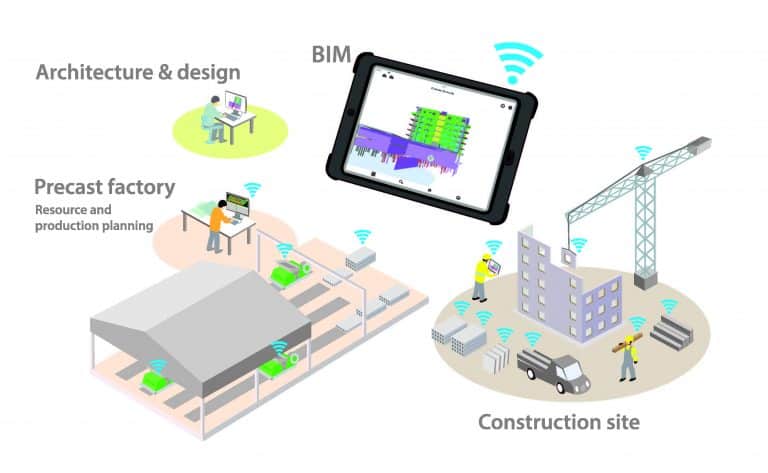A paradigm shift in construction

Digitalization is a big buzz word in every business field. In construction, the possibilities for new technology are impressive. The ICONS research project by Aalto University is a step into the future.
In today’s construction, only 30 percent of the time is used for actual production. Another 30 percent goes to logistics and traffic. And the highest number, 40 percent, goes to waiting.
The most alarming number is the 30 percent that is used for productive work, says Olli Seppänen, Professor of Practice at Aalto University.
”The productive work time can be raised to 50-60 percent. We have created a system that enables workers to minimize the time spent searching for materials or tools,” he says.
The idea is to present real-time situational awareness for everyone at the construction site. When Seppänen was previously working as a consultant solving disputes in construction, he wondered how to get an overview of the construction site as a whole.
”No one had the big picture. Real-time situational awareness exists in other areas, for example hospitals and offices, why not in construction?”
Seppänen soon realized that this was a topic well worth researching at Aalto University.
Finding the tools
The iCONS (Intelligent Construction Site) research project began in October 2016. It is followed by two other projects that delve deeper into the digital world, ReCap (Reality Capture) and DiCtion (Digitalized Construction Flows).
”The follow-up projects are linked to iCONS. First we need data, then we need to analyze that data and then we need to act based on the data analysis. This way we can make detailed plans and predict the workflow accurately.”
Other universities involved in the project include Tianjin University from China, Stanford University from California and Unicamp from Brazil. The Technion Institute of Technology from Israel is a technology partner along with Tianjin University and Trimble, a company behind the Tekla software solutions for advanced building information modeling and structural engineering. Several construction companies are either members of the consortium or are on board as observers.
The main idea of iCONS is that if everyone has access to data that shows where the people, materials and tools are, it saves a lot of time and wasted effort at the site.
For example, instead of searching endlessly around, a worker can simply check on his phone where the hammer drill is or where a certain precast element is.
”We simply place an RFID tag on the tools, materials and workers. This allows us to get information on the entire situation in real-time.”
Prefabrication 2.0
In prefabrication, the new technology opens many doors. An RFID tag can be placed on a slab already at the factory, so the construction site knows in real-time when it is sent. Both the factory and the site can monitor how and when that particular slab arrives at the site. After installation, the tag can be removed and the product checked in as installed.
This is only a simple example. When situational awareness is enabled and progress at the construction site is monitored, the gathered data can be leveraged by artificial intelligence.
This means automatic communication between the construction site and the precast concrete factory. Both have access to the same digital twin of the project, which is updated automatically according to the changes made.
”In the future, builders can see continuous automatic schedule optimization. Precast concrete producers who offer new solutions are ahead of the game for sure,” Seppänen says.
Lasse Rajala, Business Area Director at Sweco, adds that not only buildings or parts can be monitored digitally, but also machinery.
”Suppliers are able to get data about how the supplied machinery is used. This is a big improvement and helps in designing machines that meet the needs of the clients. Whenever there is a problem, the supplier can analyze the situation in real-time.”
Real-time monitoring

Olli Seppänen
Professor of Practice
School of Engineering
The iCONS project is an example of large scale progress in construction. Senior Advisor Lassi Järvinen from Elematic says that a major ambition in the whole industry is to make the construction site master everything: the prefabrication, the logistics, the whole workflow.
”From our point of view, the construction site should be controlling the precast process by ordering exactly what is needed to be delivered exactly when it is needed. We have built an integrated system with Trimble that enables this,” Järvinen says.
The EliPlan system is a resource planning solution specifically designed for precast factories. It automatically brings accurate data directly from the BIM (Building Information Model) to the production line. This helps the factory to optimize the use of resources and minimize waste.
The BIM model alone is a great tool and should be used a lot more, Järvinen says. Especially in bigger projects, companies should always make a ‘master model’ available to all parties.
Currently the providers often make their own models based on whatever information is available. Way too often this information is limited and inaccurate.
”The BIM model should be made available to every provider at the beginning. Then, the providers could easily calculate the exact amounts of resources needed. The BIM model could then be modified along the way and used as a central source of information for the entire life cycle of the building,” Järvinen says.
Rajala continues that the entire life cycle should be kept in mind more.
”Today, even if digital tools are used in construction, they are often forgotten when the project is finished.”

Baby steps
Seppänen says that the iCONS system is not yet commercialized, but that interest is growing. One major challenge is that construction sites are always at a new location.
”In other areas of industry such as car manufacturing or dockyards, the location never changes. It is easier to get data. In construction, we are taking the first steps towards new effective solutions,” Seppänen says.
However simple it may sound, it is a big step forward if everyone at the construction site is able to check where everything is.
”Workers are able to work much more efficiently and management is able to monitor the situation in real-time. For example, if you can see that the tools, the materials and the workers are in the same space, you can assume that work is going on.”
Modeling on the go
ICONS is about locating things. The follow-up project ReCap is about being able to monitor not only the situation, but also the progress of the project.
The hypothesis of iCONS is that if everyone has access to data that shows where the people, materials and tools are, it saves a lot of time and wasted effort at the site.
In current construction, the company gets a progress report typically once or twice per month. ReCap provides information in real-time.
”For example, we can equip a crane or a drone with a camera that takes pictures of the building. A 3D model of the building can be created and compared to the BIM model in real-time. This makes it possible to react immediately if something is wrong,” Seppänen explains.
The third research project, DiCtion, sees big opportunities in task assignment, logistics and waste reduction. Artificial intelligence can control and optimize workflows through data analysis.
Material orders and prefabrication can be controlled automatically. The BIM model can be updated automatically. The sky is the limit when it comes to possibilities for digital solutions, but progress is slow.
”We need more research and forward-looking companies to develop the applications further. For the first time ever, we are able to gather data for analysis. Before digitalization, all data was hidden in files and papers, impossible to process.”
Saving time and money
Lassi Järvinen sees that the whole production chain, from prefabrication to logistics to the construction site, will work a lot more efficiently in the future.
”It’s all about accessing and processing data. Not only data from the companies involved, but from the surroundings as well, for example, traffic.”
Seppänen notes that another important tool that works very well with new technology is takt time. It is the average time between the start of production of one unit and the start of production of the next unit, when these production starts are set to match the rate of customer demand.
”The idea of takt is to minimize the time wasted. This needs real-time data since everything has to run like clockwork.”
The examples are impressive. BMW in Germany and Skanska in Norway were able to reduce construction time by 50% with takt planning and execution.
The construction business is often viewed as a slow-changing industry. Järvinen and Seppänen recognize the stigma and encourage everyone to look ahead. New technology benefits the whole business.
”It is in everyone’s interest to reduce waste in time, money and materials,” Järvinen concludes.
“The construction site should be controlling the precast factory by ordering exactly what is needed to be delivered exactly when it is needed.”
Aalto University research projects
iCONS, Intelligent Construction Site
• Timeframe: October 2016 – September 2018
• Focus: Creating real-time situational awareness
• Means: Placing RFID tags on tools, materials and people
• Target: Ability to know where things and workers are in real time
ReCap, Reality Capture for Construction Management
• Timeframe: October 2017 – December 2019
• Focus: Monitoring progress in real time
• Means: Using drone cameras and augmented reality to update BIM model automatically
• Target: Improve project management, monitor safety and react to problems in real time
DiCtion, Digitalized Construction Flows
• Timeframe: January 2018 – June 2020
• Focus: Digitalizing and automating workflows
• Means: Artificial intelligence analyzing data and optimizing the construction proces
• Target: Ability to work more efficiently, reduce waste